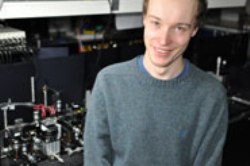A research team at the Centre for Quantum Photonics of the University of Bristol has developed a versatile optical chip that produces, measures, and controls two important quantum phenomena, mixture and entanglement, paving the way for developing quantum computers.
 Research physicist Peter Shadbolt with the quantum optical chip. (Image by University of Bristol's Centre for Quantum Photonics)
Research physicist Peter Shadbolt with the quantum optical chip. (Image by University of Bristol's Centre for Quantum Photonics)
Mixture is an undesirable effect caused by the surroundings, but now becomes useful in characterizing quantum circuits when efficiently controlled. Entanglement is the link between two remote particles. The Centre for Quantum Photonics’ Director, Professor Jeremy O'Brien stated that the novel device’s ability to manipulate and measure quantum phenomena over it is a major breakthrough towards the realization of optical quantum computing.
The dimensions of the optical chip capable of performing numerous experiments that can only be conducted on an optical bench having a size comparable to that of a large dining table is 70 x 30 mm.
The chip comprises a network of microscopic channels that are capable of directing, interacting and controlling individual photons. Photon pairs can be controlled and trapped utilizing eight reconfigurable electrodes implanted in the circuit, forming any mixed state of single photon or any trapped state of two photons.
Peter Shadbolt, one of the researchers, stated that the team has demonstrated a reconfigurable device that is capable of performing several tasks. This device is roughly ten folds more intricate than earlier experiments conducted utilizing this technology, Shadbolt said. The fact that this single reconfigurable chip is capable of performing various experiments directly is exciting, he added.
The team, which conducts research on quantum photonic chips, is now working on expanding its device’s complexity and studying the possibility of its technology as the basic component for the development of quantum computers.